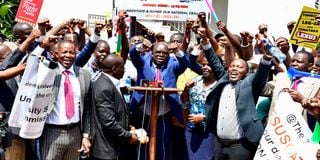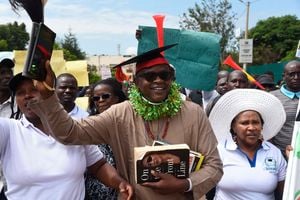
Universities Academic Staff Union Secretary General Constantine Wesonga (center) with lecturers of Technical University of Kenya on September 18, 2024 during the first day of the university lecturer’s nationwide strike.
Learning has been paralysed in all public universities across the country, plunging Kenya's higher education sector into chaos. Striking university staff are demanding better pay and good working conditions.
At the University of Nairobi, a sense of quiet urgency permeates the campus. In the lecture halls, groups of students sit scattered, some hunched over worn desks, their eyes flicking through pages of textbooks. A few others occupy seats in the far corners, their brows furrowed in concentration.
Outside, under the soft morning light, students perch on the steps, backpacks propped beside them as they read and take notes. The hallway buzzes with a quieter hum - students leaning against the walls, some sitting cross-legged on the floor with open books, engaged in whispered discussions. The atmosphere is tense yet determined, each student striving to make sense of their studies amid the uncertainty of their disrupted academic calendar.
Compounding this crisis, a recent court ruling has halted the implementation of a crucial university funding model, exacerbating the financial turmoil facing institutions and students alike.
On October 29, members of the Universities Academic Staff Union (Uasu) and Kenya Universities Staff Union (Kusu) officially launched a nationwide strike, triggered by the government's failure to implement previously agreed salary increases.
The ongoing lecturers' strike, which has seen an unpredictable on-and-off pattern, is rooted in years of unresolved grievances. Lecturers have long been confronted with stagnant wages, delayed salaries, and unfulfilled promises of improved working conditions.
Just four days ago, lecturers at the University of Nairobi disrupted classes, leaving students uncertain about their academic futures. This chaos has created uncertainty for diploma students, who are due to sit exams this month, and for undergraduates, whose exams begin at the end of December.
At many institutions, including Maseno University, Kibabii University, Masinde Muliro University, University of Nairobi, Kenyatta University and Jomo Kenyatta University of Agriculture and Technology, students are taking CATs online but not attending lectures.
“We were supposed to start our CATs this week, but they got postponed. We don’t know if the same will happen next week. With no lectures, we’re left to study alone,” said Mark Mwambu, a student at the University of Nairobi.
The lecture halls at Maseno University are empty as students prepare for a future that seems uncertain.
"At Kibabii University, we're taking CATs, but there are no classes. The university funding model has been halted by the courts, and we're just on edge, waiting to hear if we'll even be able to sit our main exams," said Mary Khisa, a student at Kibabii University.
Kusu chairman Charles Mukhwaya sounded the alarm over the deepening financial crisis gripping Kenya's universities, citing chronic underfunding as the core problem.
"The crisis in universities or higher education in this country is not something that we can fail to observe. The problem with universities is underfunding," he said.
He accused the government of shifting its focus and reallocating resources away from universities. He pointed out that the redirection of funds to Technical and Vocational Education and Training (TVET) institutions has left universities cash-strapped.
"The government has moved and taken its foot off the accelerator, which started about eight years ago. Money that was supposed to go to universities was diverted to TVETs and universities have been left in financial turmoil," he noted.
Mr Mukwaya further said the government's new student-centred funding model could deepen the crisis. Under this model, public funding follows students based on their choice of university. While this approach aims to enhance student choice, it puts institutions at risk: if students do not enrol, the university will not receive government funding.
The KUSU chairman warned that this could lead to closures, especially for state-run institutions, as funding shortfalls affect staff salaries and operating budgets.
The new funding model won't help because it is a student-centered approach. This means that the money from the government will follow the student to the university to which he or she is admitted. If the student does not go to a particular university, the money will not go to that university. These are public universities and must be funded by the state," he stressed.
He further explained that this model could lead to a situation where university staff would have to rely on student fees for their salaries.
"For a lecturer or staff member to get paid, they have to wait for the student to pay the fees. They must pay fees before the university can operate. Now tell me, even in primary education, do the teachers wait for the learners to pay fees to get their salaries? If fees are not paid, lecturers won't be paid and the students will not attend classes because of strikes," he warned.
He stressed that many students, especially those from disadvantaged backgrounds, could be left out of higher education if this model continues.
"Parents are being told to pay for their children's education, but many families simply don't have the resources. The majority of students in public universities come from poor families. The rich, on the other hand, send their children to private universities or abroad," he said.
The Kusu leader called for a government-led paradigm shift in the funding of higher education. He noted that current budget allocations fall short of the recommended six percent of the country's GDP, with less than four percent currently allocated to education. This shortfall, he said, underscores the need for a renewed commitment to supporting higher education as a pillar of national development.
"There is a need to depoliticise the resources that go to universities and ensure that funding is increased. Our education budget should be at least six percent of GDP, but it's currently less than four percent," he said.
Mr Mukhwaya suggested that an extension of the Differentiated Unit Cost (DUC) model could provide a temporary solution to keep universities operational while funding issues are addressed.
"The government must take the lead in resolving this crisis," he said.
On October 26, however, lecturers signed a return-to-work formula with the Federation of Kenya Employers. The agreement includes provisions for salary adjustments to address long-standing grievances. It provides for a 7 percent increase for grades 13A, 14A and 15A, while grades 10A, 11A and 12A will receive a 10 percent increase in their basic monthly salaries.
The Collective Bargaining Agreement for the 2021-2025 cycle will now encompass the last two years, effective July 1, 2023.
“The salary scales for the Financial Year 2023/2024 and Financial Year 2024/2025 will be implemented in the salaries of October 2024. Consequently, the CBA for this cycle will cover the last two years beginning July 1, 2023,” outlined a portion of the agreement.







